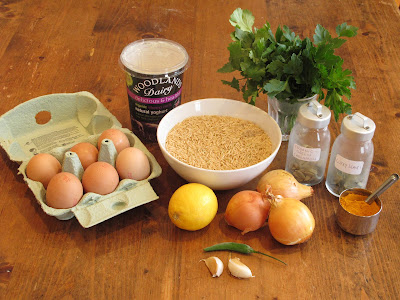With an extra double cream in the fridge and a small amount of butter, which was about to run out, I thought it would be a good idea to make butter and post the recipe to show how easy it is to make our own butter (it requires some patient but it is very rewarding).
I have already declared my love for butter in this previous post.
I hope you enjoy it!
 |
| The ingredients |
 |
| Pour the double cream into a food processor. Blend for approx 5 minutes |
 |
| It first will look like a whipped cream |
 |
| Then very stiff |
 |
| Finally the buttermilk separates from the cream |
 |
| Put the cream inside a clean cheesecloth or a sieve |
 |
| Squeeze the cream really well |
 |
| Put the cream back into the clean food processor with 100ml chilled water |
 |
| At the first strain the water will look like this |
 |
| By the 7th time it will look like this |
 |
| My homemade butter! 500ml of double cream = 225g butter |
 |
| You can wrap the butter in a greaseproof paper... |
 |
| or put it in a butter dish |
 |
| Spread it on a hot slice of toast! |
Homemade Butter
Yields 225g
INGREDIENTS
500ml organic unpasteurised or pasteurised double cream (at room temperature).
700-800ml chilled water
METHOD
METHOD
Pour the double cream into a food processor. Process it for about 5 minutes. It first will look like a softly whipped cream, then very stiff, and finally the cream will collapse and the buttermilk will separate from the cream.
Turn the mixture into a cold, clean cheesecloth or sieve, and drain well. Squeeze the cream really well until you think the buttermilk has been thoroughly drained. Be careful not to do it for too long. If you handle the butter too much with warm hands it will liquefy.
Put the cream back into the clean food processor with 100 ml very cold water. This is important to clear any buttermilk left in the butter, as it will make the butter go off and taste rancid quickly. Sieve and repeat this process until the water is clear (this could take about 7-8 times).
Wrap in a greaseproof or waxed paper (or use a butter mould/dish) and keep chilled in a fridge. The butter also freezes well.
You can drink the buttermilk (see below - it doesn’t taste sour) or use it to make sode bread, pancakes or biscuits.
Flavoured butter
You can add crushed garlic, salt, fresh or dried herbs, and spices. If you are freezing the butter, do not salt or flavour it as the freezing process enhances the saltiness.
Spiced buttermilk
 |
| Buttermilk |
 |
| Spiced buttermilk |
This is classic Indian aperitif (very similar to lassi), served in a small glass.
Blend ½ cup of buttermilk, 1 glass of chilled water (or add some ice), some coriander leaves, mint leaves, cumin powder and sea salt. Drink immediately.
The main ingredients and their healthy benefits
Buttermilk: It contains very good levels of calcium and protein. It also contains vitamin A and C, and a number of B vitamins (B1, B2, B3 and B5). Buttermilk also has minerals like iron, magnesium, phosphorus, potassium and zinc.
Organic Butter: It’s a rich source of vitamin A, D, E and K. It contains an essential fatty acid called CLA (conjugated linoleic acid) which research has shown that it can contribute to a cancer-protecting diet. Thirty percent of the fat from butter is from monounsaturated fats (the same type found in olive oil). It has antiviral and antimicrobial properties. It is rich in the powerful mineral selenium. Look for good quality butter, like raw and cultured. I have previously mentioned some suppliers here.
Till next week!
Till next week!





















